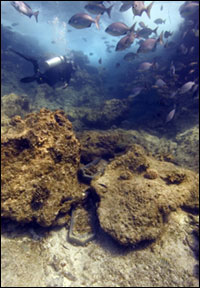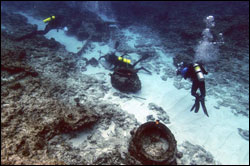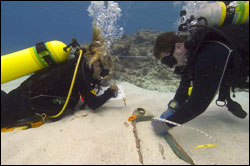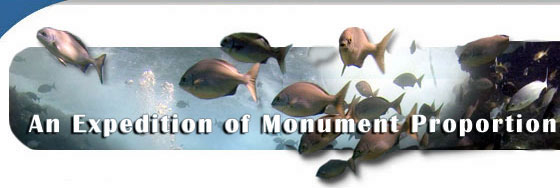|
Mission Plan
From June 23 through July 20, 2006, a multidisciplinary team of scientists, archaeologists and educators will explore the Northwestern Hawaiian Islands.
 | | Maritime Archaeologist swims near scattered artifacts outside of the reef in the NWHI. |
The mapping team is made up of oceanographers, coastal geologists, geographic information system specialists and seafloor video analysts. The mapping team will operate one of two multi-beam mapping systems installed on the ship to generate high-resolution bathymetric data and acoustic backscatter imagery. This technology provides information about the composition of the seafloor, such as whether the bottom is rocky or sandy. These very detailed and accurate map products help to delineate habitat suitable for corals, fish, endangered Hawaiian monk seals and other organisms inhabiting the atolls. The mapping research has proven to be a critical tool for marine resource managers and scientists.
In addition to shipboard mapping work being conducted day and night, the 25-ft survey launch, the R/V Ahi is also equipped with a multi-beam system and will be launched each morning to map shallower portions of the atolls, where it is unsafe to navigate the larger research vessel.
 | | Maritime Archaeologists map the remains of a 19th century whaling ship at Pearl and Hermes Atoll. |
The team of six maritime archaeologists from the NOAA Maritime Heritage Program will conduct underwater archaeological surveys at several shipwreck sites at Kure Atoll and Pearl and Hermes Atoll. The team’s work at Pearl and Hermes Atoll will, in addition to several other tasks, continue work on the whaling shipwrecks discovered at this atoll in 2004 and thought to be the underwater archaeological remains of the whale ships Pearl and Hermes, for which these atolls were named. Work at Kure Atoll will include returning to the site of the USS Saginaw, discovered in 2003 and an amazing story of survival at sea, as well as further survey of an unidentified 19th century whaling shipwreck thought to be the Parker. The Northwestern Hawaiian Islands contain some of the world’s most beautiful and untouched submerged cultural resources and the opportunity for the team to survey these sites in 2006 will allow scientists to bring these remote shipwreck sites to the public.
 | | Maritime Archaeologists map artifacts at a whaling shipwreck at Pearl and Hermes Atoll. |
The education and outreach team will work with all of the scientists and crew aboard the NOAA ship to interpret this exciting research as well as broaden interpretation of the region in general for a diverse audience through several established mechanisms. Data collected on this research cruise and other cruises aboard the NOAA ship Hi’ialakai help to make important management decisions in support of the Northwestern Hawaiian Islands Marine National Monument, State Marine Refuge and the Hawaiian Islands National Wildlife Refuge. Understanding the near-pristine marine environment and valuable heritage resources of the Northwestern Hawaiian Island atolls is an important step towards generating stewardship and inspiring an interest in conserving this ocean wilderness for future generations. Scientists aboard the vessel in June and July 2006 will work to interpret and deliver this message to the public.
|



